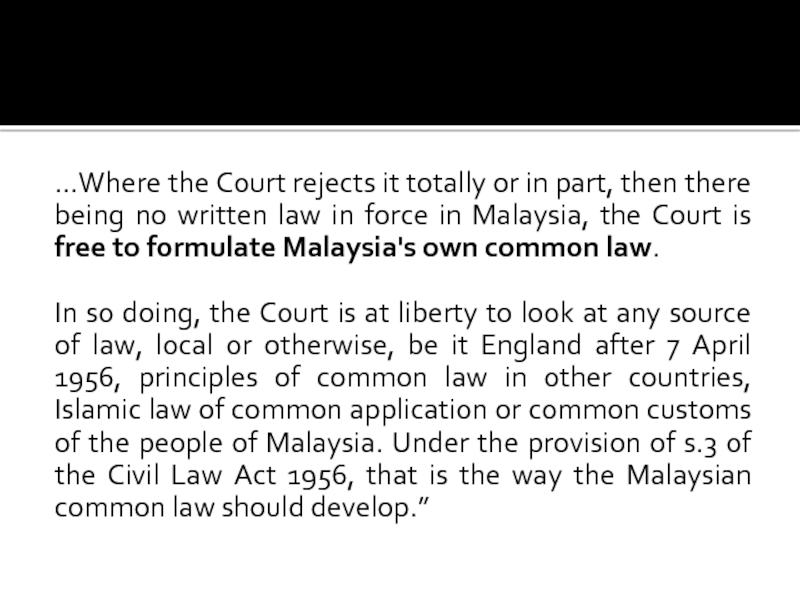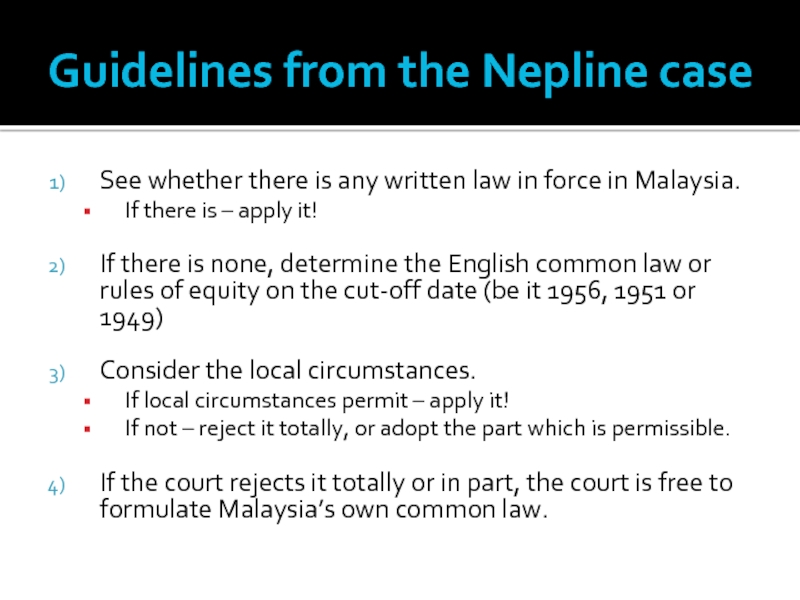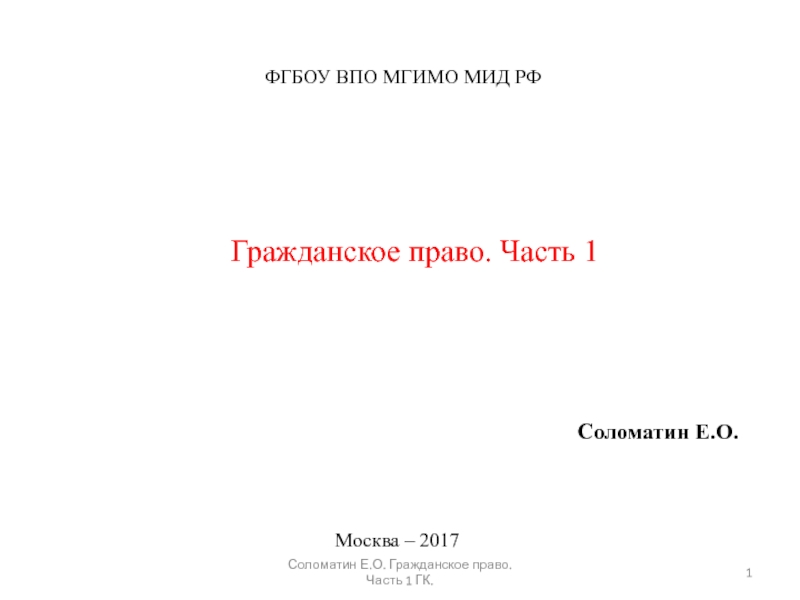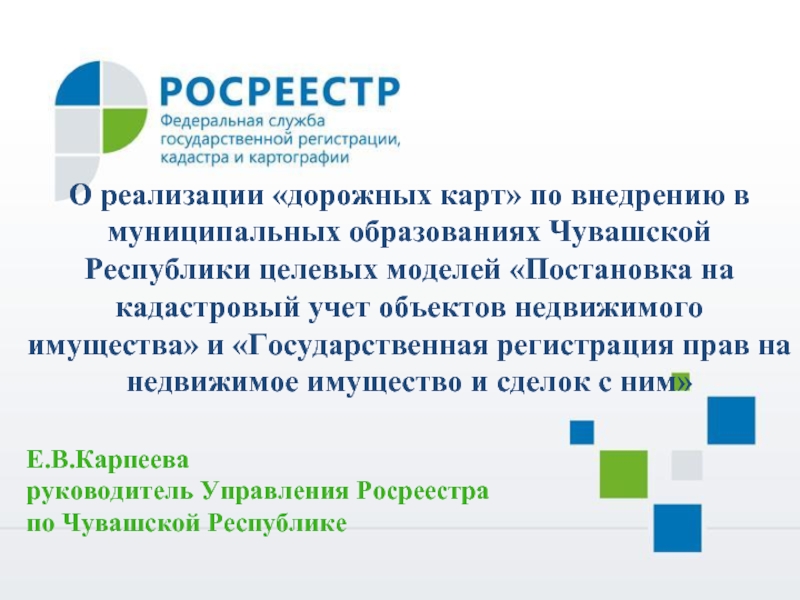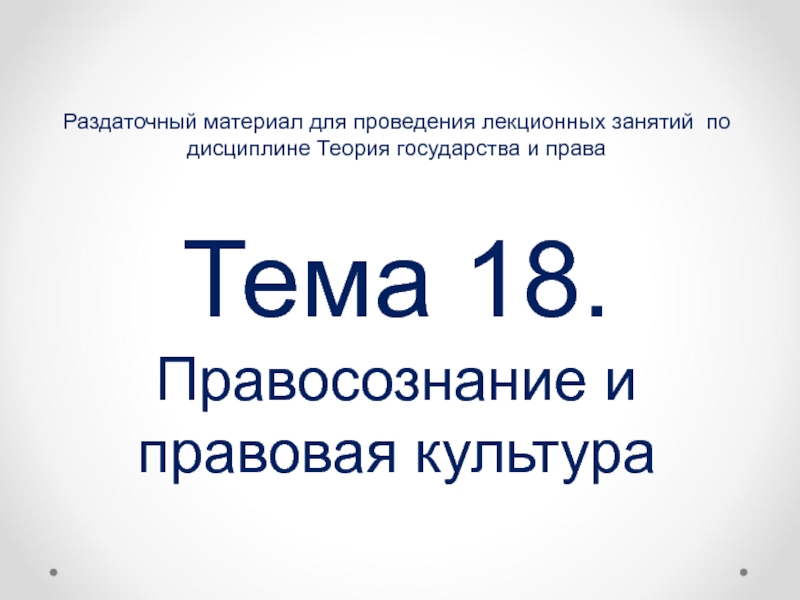- Главная
- Разное
- Дизайн
- Бизнес и предпринимательство
- Аналитика
- Образование
- Развлечения
- Красота и здоровье
- Финансы
- Государство
- Путешествия
- Спорт
- Недвижимость
- Армия
- Графика
- Культурология
- Еда и кулинария
- Лингвистика
- Английский язык
- Астрономия
- Алгебра
- Биология
- География
- Детские презентации
- Информатика
- История
- Литература
- Маркетинг
- Математика
- Медицина
- Менеджмент
- Музыка
- МХК
- Немецкий язык
- ОБЖ
- Обществознание
- Окружающий мир
- Педагогика
- Русский язык
- Технология
- Физика
- Философия
- Химия
- Шаблоны, картинки для презентаций
- Экология
- Экономика
- Юриспруденция
SOURCES OF LAWEnglish Law презентация
Содержание
- 1. SOURCES OF LAWEnglish Law
- 2. Definition of “law” Article 160 FC “law”
- 3. Definition of “common law” Section 3 Interpretation
- 4. Historical background on reception of English law
- 5. Sabah: Civil Law Ordinance 1878 Civil
- 6. Current application of English law Civil Law
- 7. Civil Law Act 1956 (Revised 1972) Date
- 8. Applicable to civil cases only Sia Cheng
- 9. Section 3 of CLA 1956
- 10. Section 3 Application of U.K. common law,
- 11. Meaning of “Court” (1) Save so far
- 12. Section 2 CLA 1956 “Court” means
- 13. Section 3(1)(a) CLA 1956 (a) in Peninsular
- 14. Section 3(1)(b) CLA 1956 (b) in Sabah,
- 15. Section 3(1)(c) CLA 1956 (c) in Sarawak,
- 16. Comparison PENINSULAR MALAYSIA Common law of England
- 17. What is common law? Law developed by
- 18. What is “rules of equity”? There were
- 19. A set of legal principles, in
- 20. What is “statutes of general application”? “the
- 21. Statutes enumerated in 2nd Sch of CLA applicable to Sarawak
- 23. Whether statutes of general application are also
- 24. Similarly, in these cases, it was
- 25. Mokhtar v Arumugam [1959] 1 MLJ 232
- 26. Proviso to Section 3 Provided always that
- 27. Flashback… Royal Charter of Justice 1807 “so
- 28. PL Narayanan v PL Subarmaniam [1998] 4
- 29. Application of English law only if not provided by our written law
- 30. (1) Save so far as other
- 31. Dato Seri Anwar Ibrahim v PP [2010]
- 32. Application of English law only at its effective date
- 33. The cut-off dates Only English common law
- 34. Lee Kee Chong v Empat Nombor Ekor
- 35. Pang Soo v. Tong Ah Company Sdn
- 36. Leong Bee v Ling Nam Rubber Works
- 37. Therefore, if the common law is
- 38. Jamil bin Harun v Yang Kamsiah [1984]
- 39. It was argued that section 3
- 40. This argument was rejected by the
- 41. In other words: In the absence
- 42. “so far only as the circumstances of
- 43. Commonwealth of Australia v Midford (Malaysia) Sdn.
- 44. Nepline v Jones Lang Wootton [1995] 1
- 45. Syarikat Batu Sinar v UMBF Finance [1990]
- 46. Guidelines on the application of English law The Nepline case
- 47. Nepline v Jones Lang Wootton [1995] 1
- 48. …Where the Court rejects it totally
- 49. Guidelines from the Nepline case See whether
- 50. In formulating Malaysia’s own common law,
Слайд 2Definition of “law”
Article 160 FC
“law” includes written law, the common law
Слайд 3Definition of “common law”
Section 3 Interpretation Acts 948 and 1967:
“common law”
Слайд 4Historical background on reception of English law
Straits Settlements:
Royal Charter of Justice
Royal Charter of Justice 1826 – Malacca & Singapore
Malay States:
Civil Law Enactment 1937 – FMS
Civil Law (Extension) Ordinance 1951 – UFMS
Слайд 5
Sabah:
Civil Law Ordinance 1878
Civil Law Ordinance 1938
Application of Laws Ordinance 1951
Sarawak:
Order
Application of Laws Ordinance 1949
Слайд 6Current application of English law
Civil Law Act 1956 (Federation of Malaya
Was revised in 1972 to include Sabah and Sarawak
-- Civil Law Act 1956 (Revised 1972)
Слайд 7Civil Law Act 1956 (Revised 1972)
Date of coming into force:
7 April
4 April 1972 for East Malaysia
Слайд 8Applicable to civil cases only
Sia Cheng Soon v Tengku Ismail Tengku
CLA 1956 concerns civil law, not criminal law. The title of the Act says so. The preamble also provides:
"An Act relating to the civil law to be administered in Malaysia."
Слайд 10Section 3
Application of U.K. common law, rules of equity and certain
3. (1) Save so far as other provision has been made or may hereafter be made by any written law in force in Malaysia, the Court shall—
(a) in Peninsular Malaysia or any part thereof, apply the common law of England and the rules of equity as administered in England on the 7 April 1956;
(b) in Sabah, apply the common law of England and the rules of equity, together with statutes of general application, as administered or in force in England on 1 December 1951;
(c) in Sarawak, apply the common law of England and the rules of equity, together with statutes of general application, as administered or in force in England on 12 December 1949,
Provided always that the said common law, rules of equity and statutes of general application shall be applied so far only as the circumstances of the States of Malaysia and their respective inhabitants permit and subject to such qualifications as local circumstances render necessary.
Слайд 11Meaning of “Court”
(1) Save so far as other provision has been
Слайд 12
Section 2 CLA 1956
“Court” means any court in Malaysia of competent
Section 3 Interpretation Act 1948 and 1967
“court” means a court of competent jurisdiction
Слайд 13Section 3(1)(a) CLA 1956
(a) in Peninsular Malaysia or any part thereof,
Слайд 14Section 3(1)(b) CLA 1956
(b) in Sabah, apply the common law of
Слайд 15Section 3(1)(c) CLA 1956
(c) in Sarawak, apply the common law of
Слайд 16Comparison
PENINSULAR MALAYSIA
Common law of England
Rules of equity
Cut-off date:
7 April 1956
SABAH &
Common law of England
Rules of equity
Together with statutes of general application
Cut-off date:
1 December 1951 (Sabah)
12 December 1949 (Sarawak)
Слайд 17What is common law?
Law developed by judges through decisions of court.
Enforced through the doctrine of binding precedent.
Слайд 18What is “rules of equity”?
There were two parallel court systems in
‘courts of law’ which enforced legal justice, and
‘courts of equity’
Equity means 'fairness' and is the body of rules developed first by the Lord Chancellor and by the old Court of Chancery
Слайд 19
A set of legal principles, in jurisdictions following the English common
Слайд 20What is “statutes of general application”?
“the reasons for deciding that a
Per Roberts CJ in Bong Sau Fei v Chong Chu Lien [1965-86] 2 BLR 124
Слайд 23Whether statutes of general application are also applicable to Peninsular Malaysia
2
What about the court’s view on this matter?
Ong Guan Hua v Chong
Court held that the English Gaming Act of 1710 and 1835 was not applicable in West Malaysia.
Слайд 24
Similarly, in these cases, it was held that English statutes were
Permodalan Plantation v Rachuta [1985] 1 MLJ 157
Mokhtar v Arumugam [1959] 1 MLJ 232
Pushpah v Malaysian Cooperative Insurance Society [1995] 2 MLJ 657
Слайд 25Mokhtar v Arumugam [1959] 1 MLJ 232
Court:
“It is quite clear that
Слайд 26Proviso to Section 3
Provided always that the said common law, rules
Слайд 27Flashback…
Royal Charter of Justice 1807
“so far as local circumstances will admit”
“so
Proviso to Section 2 CLE 1937 (FMS)
“so far only as the circumstances of the Federated Malay States and its inhabitants permit and subject to such qualifications as local circumstances render necessary”
Слайд 28PL Narayanan v PL Subarmaniam [1998] 4 CLJ Supp 428
“Under the
Per Jeffrey Tan J
Слайд 30
(1) Save so far as other provision has been made or
Слайд 31Dato Seri Anwar Ibrahim v PP [2010] 7 CLJ 397
Once there
Слайд 33The cut-off dates
Only English common law and rules of equity administered
Only English common law and rules of equity together with statutes of general application administered in England on 1 December 1951 (Sabah) or 12 December 1949 (Sarawak) can be applied to fill in the lacuna in the law.
Слайд 34Lee Kee Chong v Empat Nombor Ekor
Court: when referring to English
Слайд 35Pang Soo v. Tong Ah Company Sdn Bhd [2010] 2 CLJ
Nuisance is a cause of action under English law. According to S 3 CLA, the common law that has to be applied is the common law in England before 7 April 1956.
Слайд 36Leong Bee v Ling Nam Rubber Works [1970] 2 MLJ 45
A
Слайд 37
Therefore, if the common law is no longer valid in England,
Слайд 38Jamil bin Harun v Yang Kamsiah [1984] 1 MLJ 217
The Federal
Слайд 39
It was argued that section 3 CLA prevents the Malaysian courts
Слайд 40
This argument was rejected by the Privy Council.
There was no written
“The courts of Malaysia are free to take their own course.”
Modern English authorities may be persuasive but are not binding.
Слайд 41
In other words:
In the absence of written law prohibiting the application
Слайд 42“so far only as the circumstances of the States of Malaysia
Слайд 43Commonwealth of Australia v Midford (Malaysia) Sdn. Bhd. [1990] 1 CLJ
Section 3 of the Civil Law Act 1956 only requires any Court in West Malaysia to apply the common law and the rules of equity as administered in England on 7 April 1956. That does not mean that the common law and rules of equity as applied in this country must remain static and do not develop.
Слайд 44Nepline v Jones Lang Wootton [1995] 1 CLJ 865
Court applied the
Abdul Hamid J:
“I think I am entitled to go on and consider whether local circumstances would require some "modification" to extend the concept of the duty of care to an omission as in this case. As I have said, I think the proviso to s. 3 of the Civil Law Act 1956 allows me to do so if local circumstances so require. Indeed the same thing was done by Peh J in Batu Sinar 's case. In fact it can be said that the Supreme Court in Commonwealth of Australia's case did just that when it applied the post 1956 decisions of the English Courts, even though the judgment did not say so.”
Слайд 45Syarikat Batu Sinar v UMBF Finance [1990]
Court applied the proviso to
“The practice in West Malaysia would constitute such a distinctive local circumstance of the local inhabitants of West Malaysia that the decision of Moorgate and other cases directly and indirectly on the point of failure to have an ownership claim registered should not be followed. We have to develop our own common law just like what Australia has been doing by directing our minds to the 'local circumstances' or 'local inhabitants.”
Слайд 47Nepline v Jones Lang Wootton [1995] 1 CLJ 865
Abdul Hamid J:
“In
If there is none, then the Court should determine what is the common law of, and the rules of equity as administered in England on 7 April 1956.
Having done that the Court should consider whether "local circumstances" and "local inhabitants" permit its application as such. If it is "permissible" the Court should apply it. If not, the Court is free to reject it totally or adopt any part which is "permissible“…
Слайд 48
…Where the Court rejects it totally or in part, then there
In so doing, the Court is at liberty to look at any source of law, local or otherwise, be it England after 7 April 1956, principles of common law in other countries, Islamic law of common application or common customs of the people of Malaysia. Under the provision of s.3 of the Civil Law Act 1956, that is the way the Malaysian common law should develop.”
Слайд 49Guidelines from the Nepline case
See whether there is any written law
If there is – apply it!
If there is none, determine the English common law or rules of equity on the cut-off date (be it 1956, 1951 or 1949)
Consider the local circumstances.
If local circumstances permit – apply it!
If not – reject it totally, or adopt the part which is permissible.
If the court rejects it totally or in part, the court is free to formulate Malaysia’s own common law.
Слайд 50
In formulating Malaysia’s own common law, the court is free to
The common law of England after the cut-off date, statutes of general application after 1951/1949, principles of common law in other countries, common custom of people of Malaysia etc.
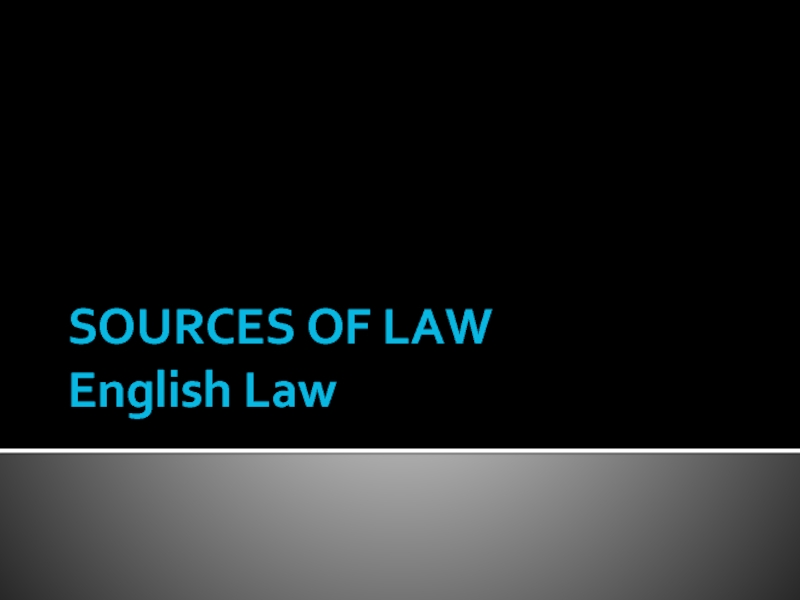
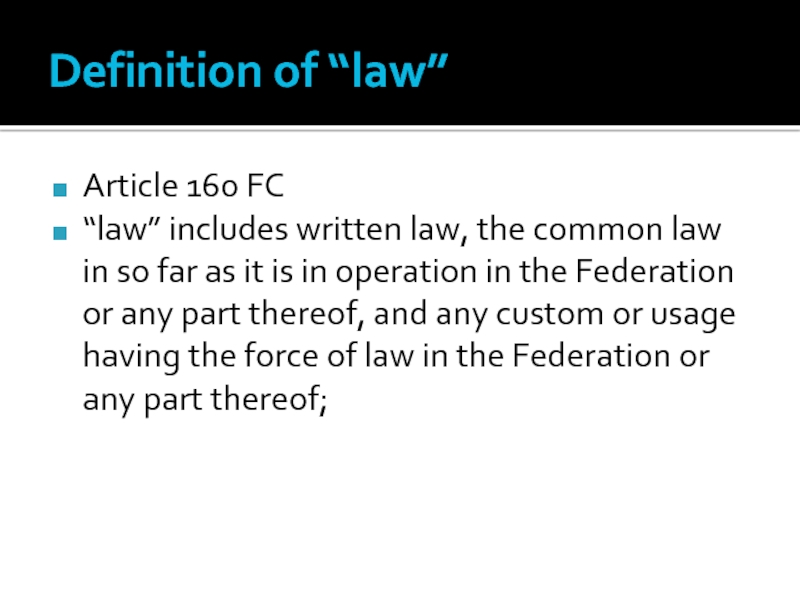
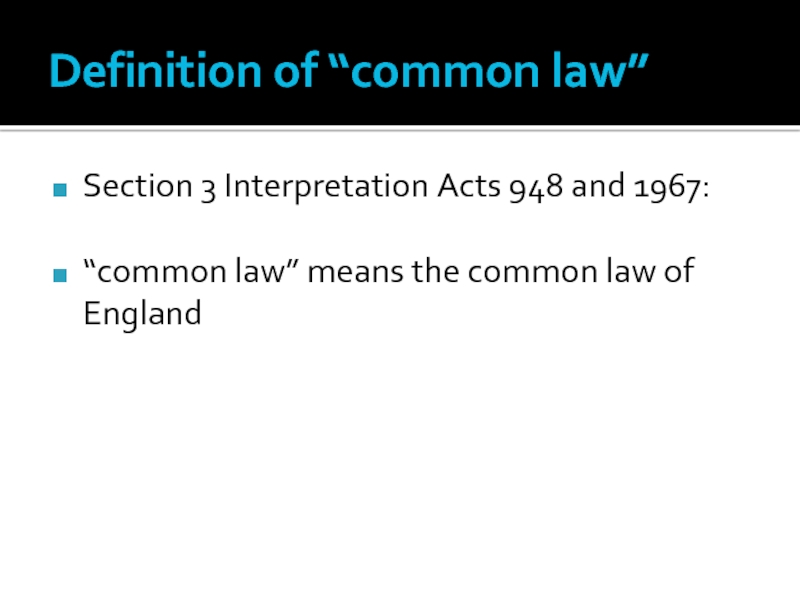
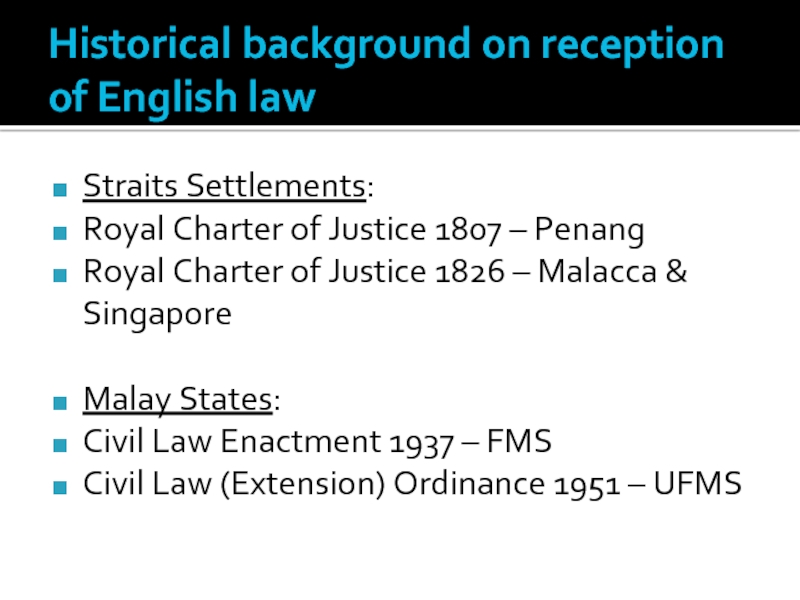
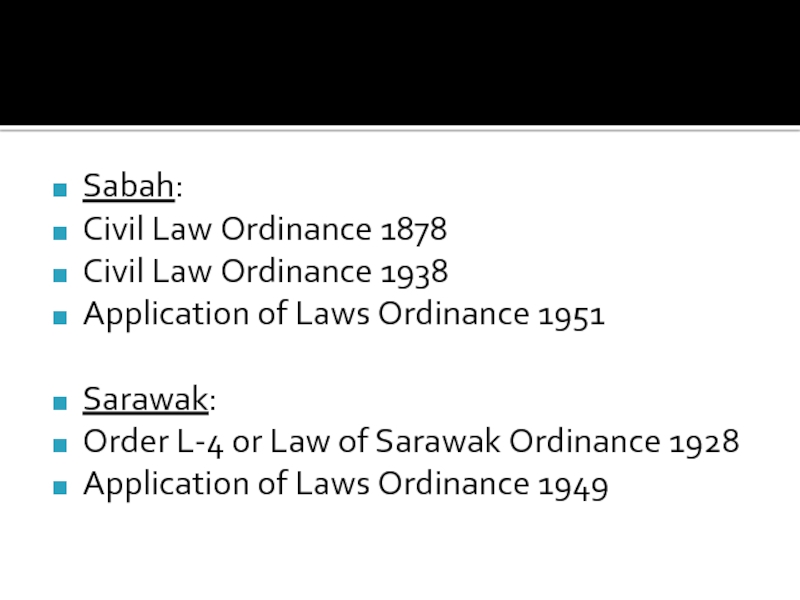
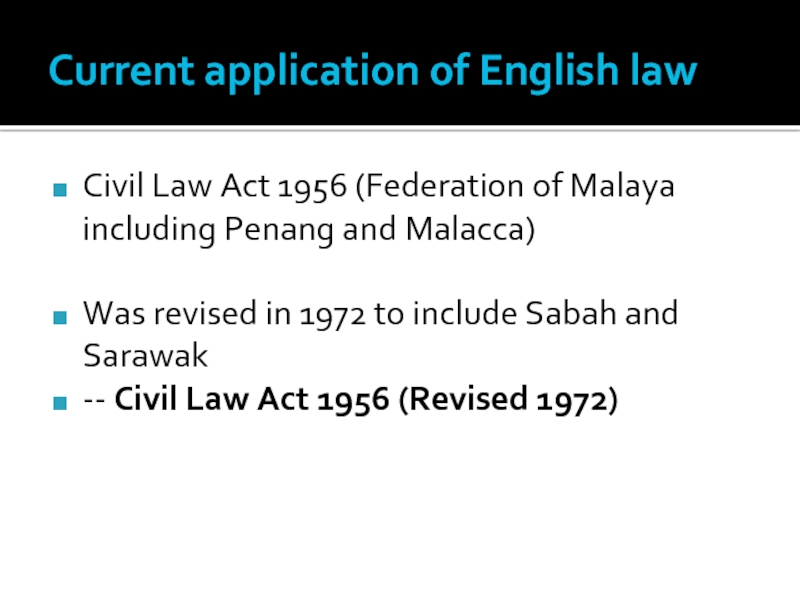
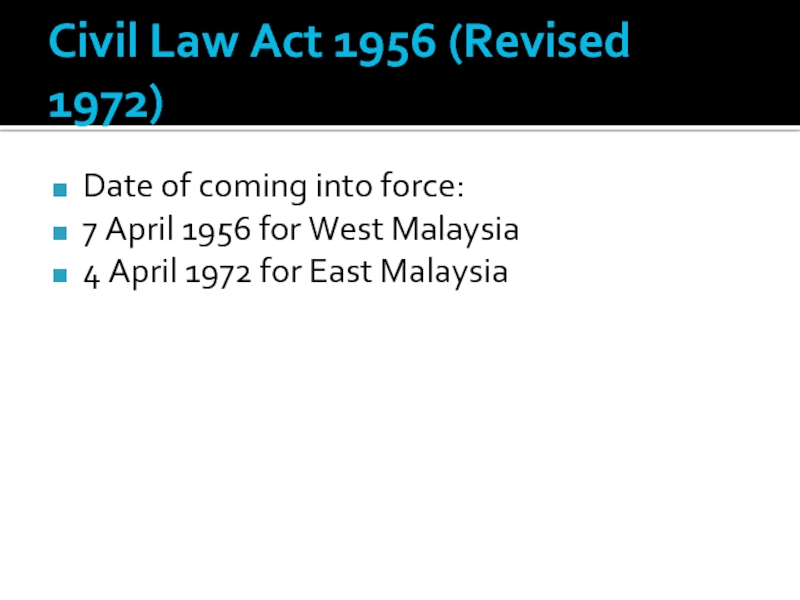
![Applicable to civil cases onlySia Cheng Soon v Tengku Ismail Tengku Ibrahim [2008] 5 CLJ](/img/tmb/1/25189/45c418f5d9e6dbef7c08540b1389501f-800x.jpg)
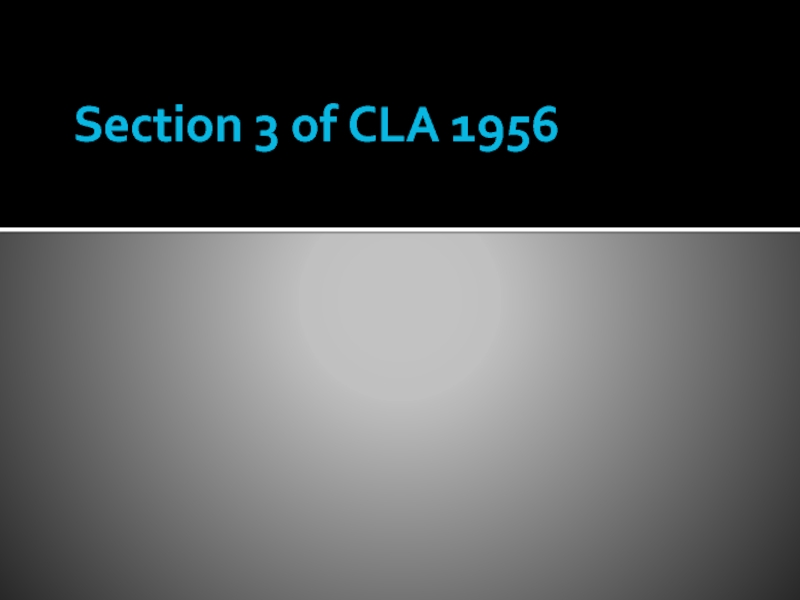
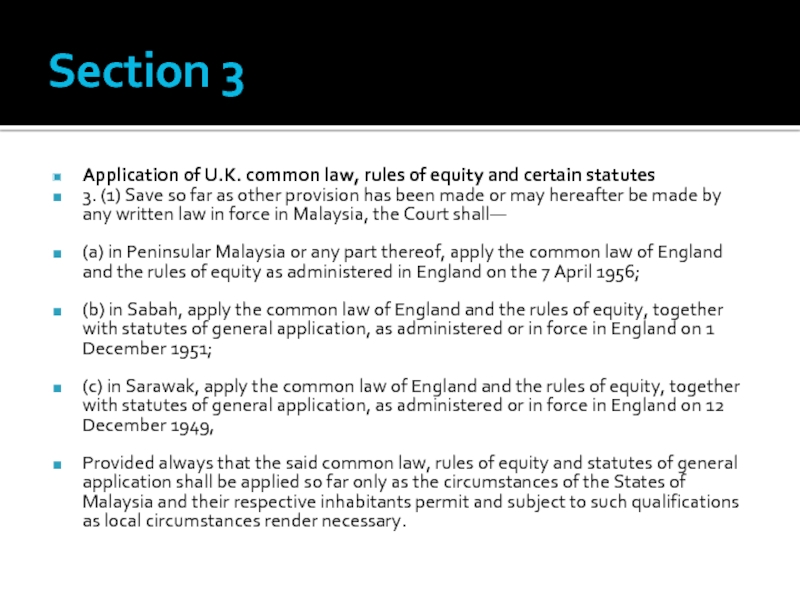
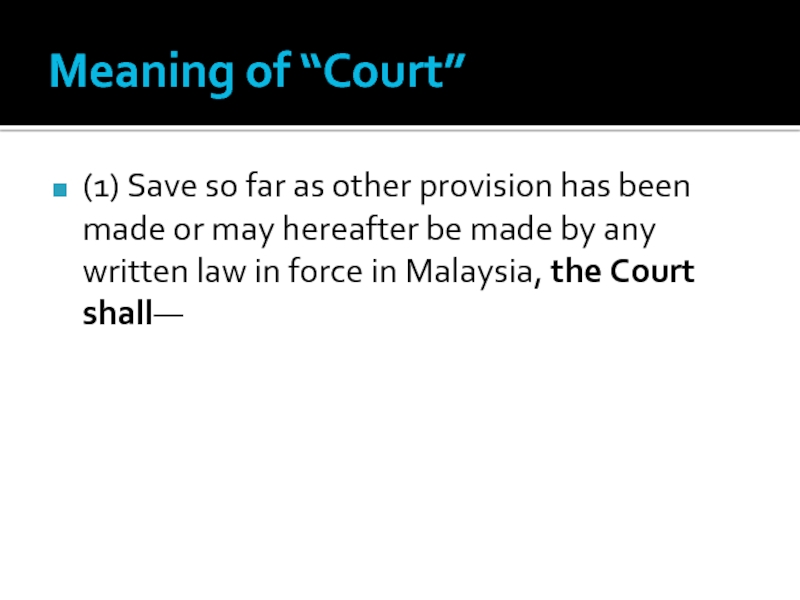
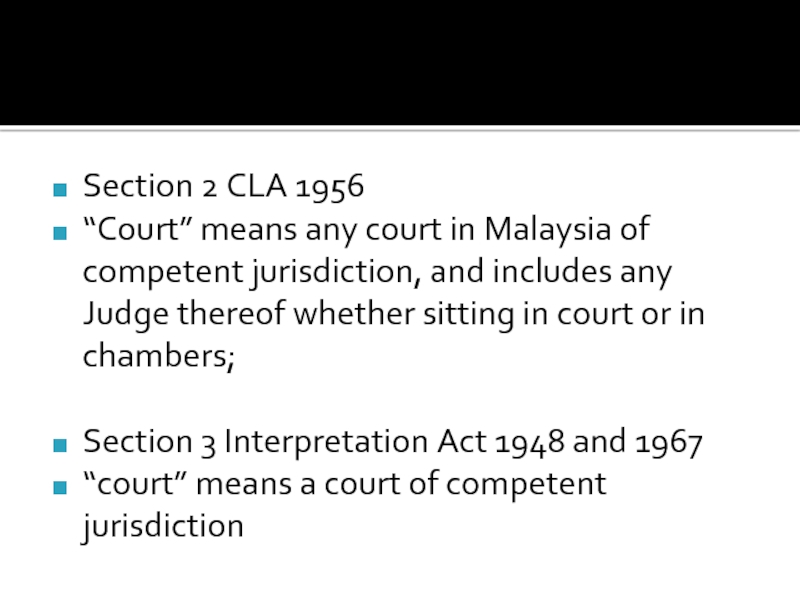
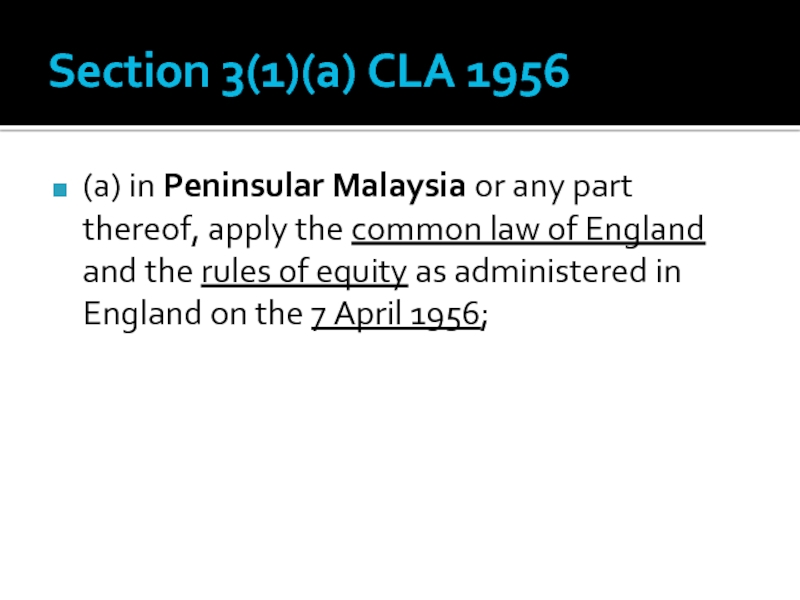
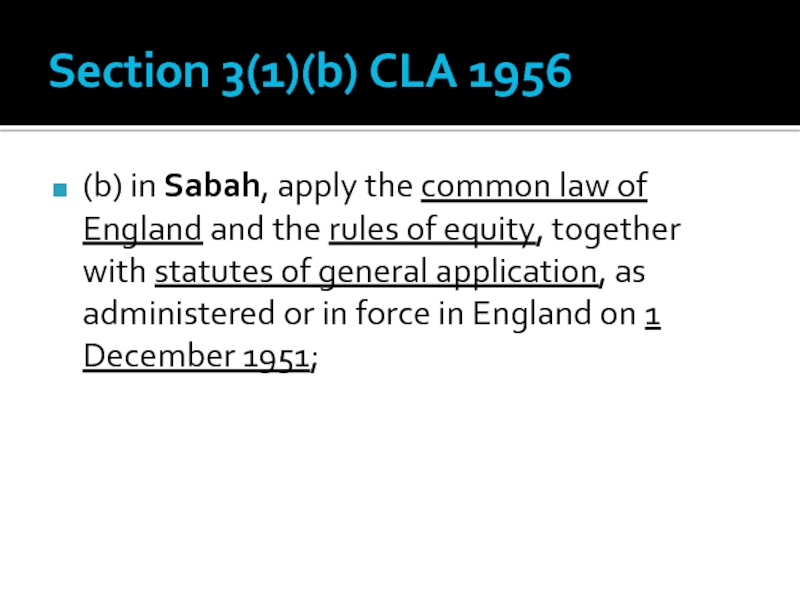
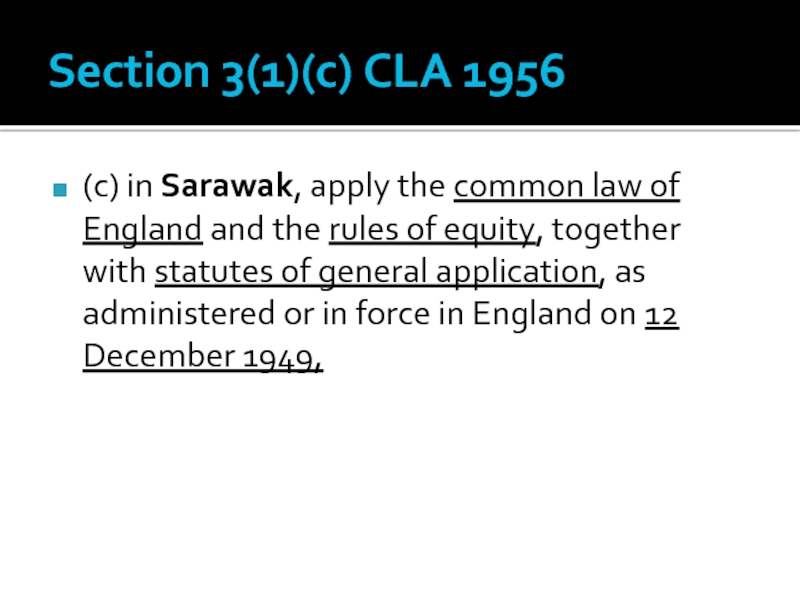
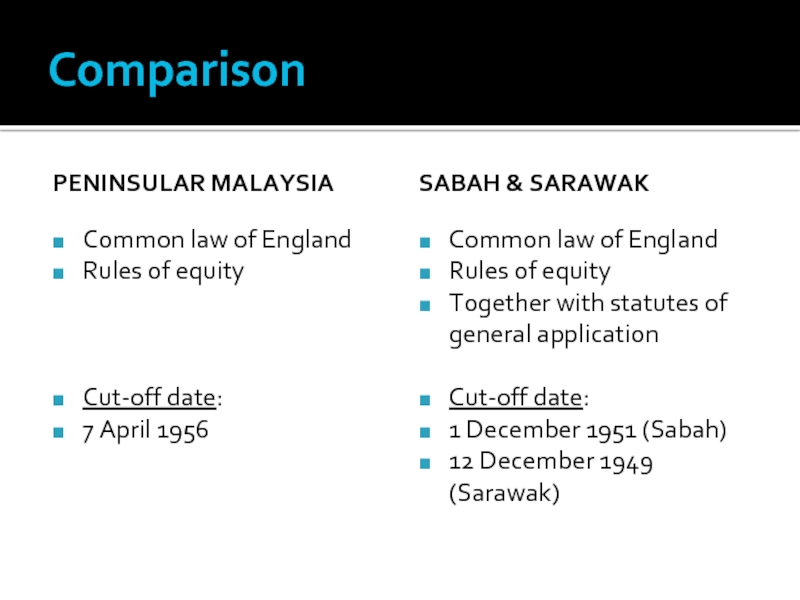
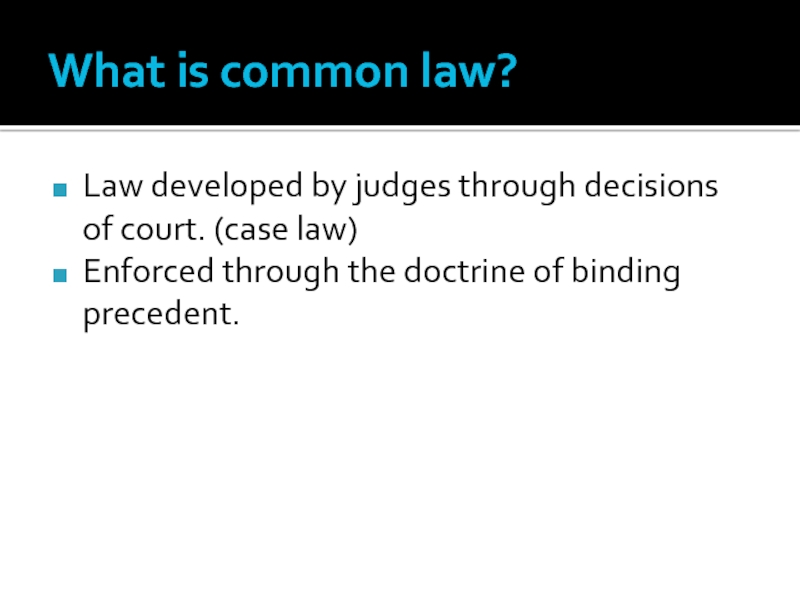
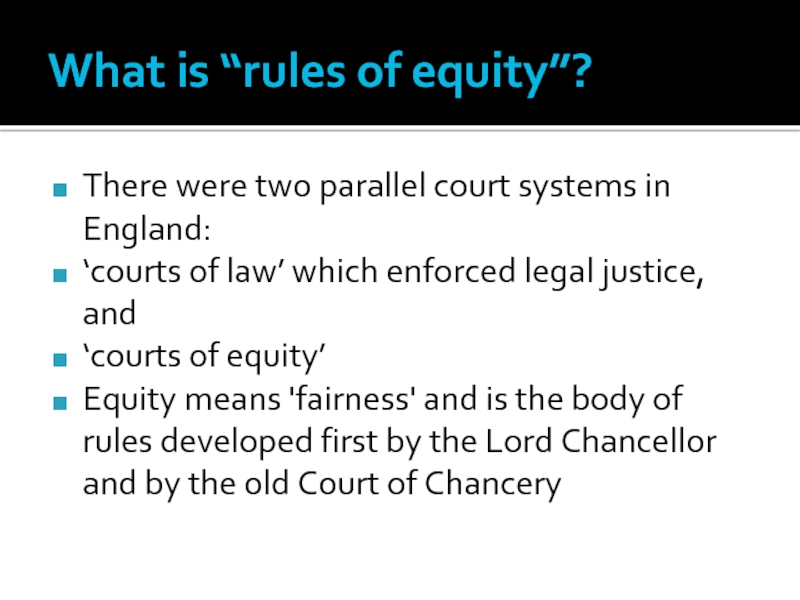
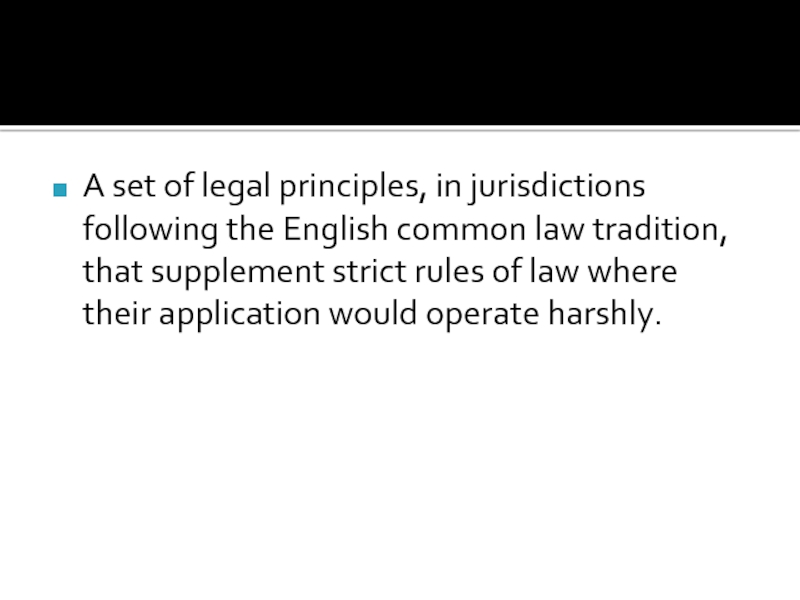
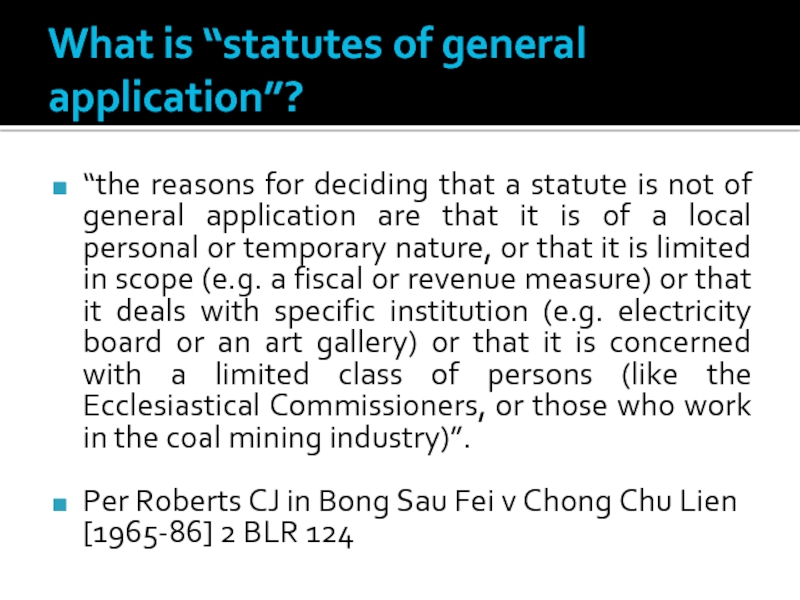
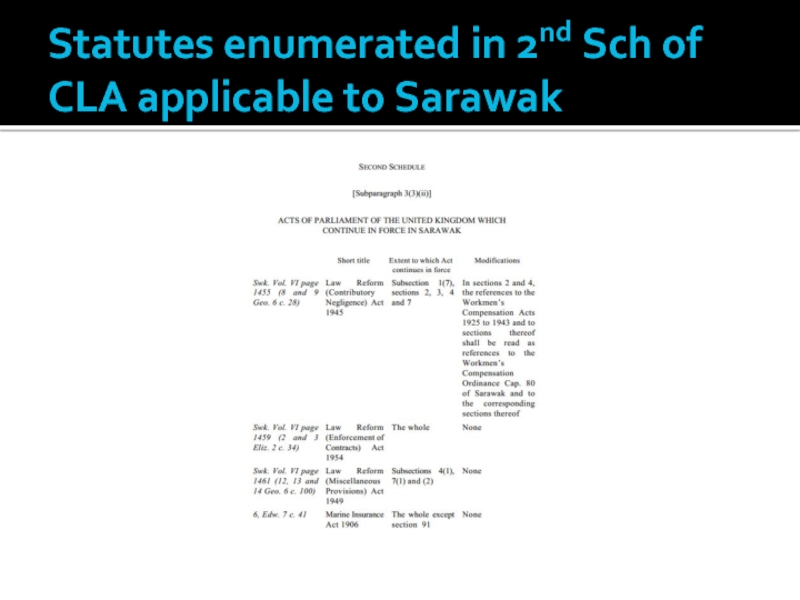
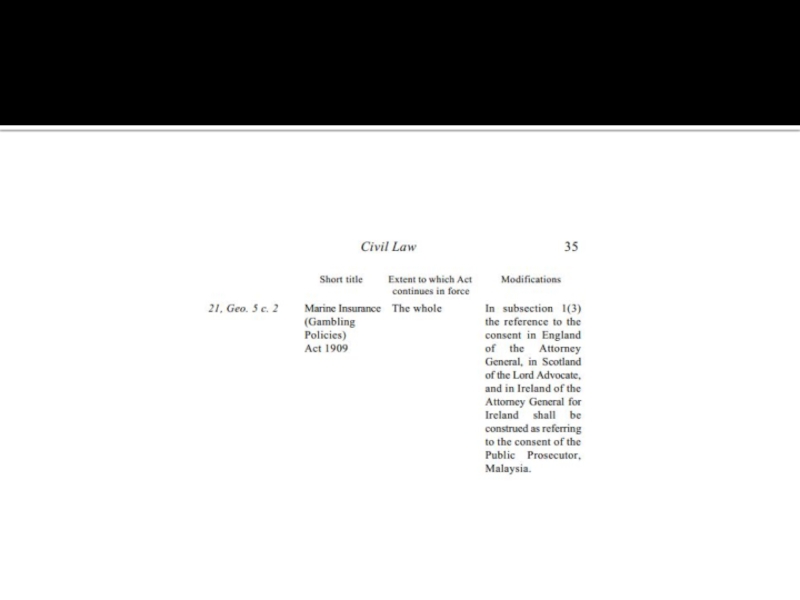
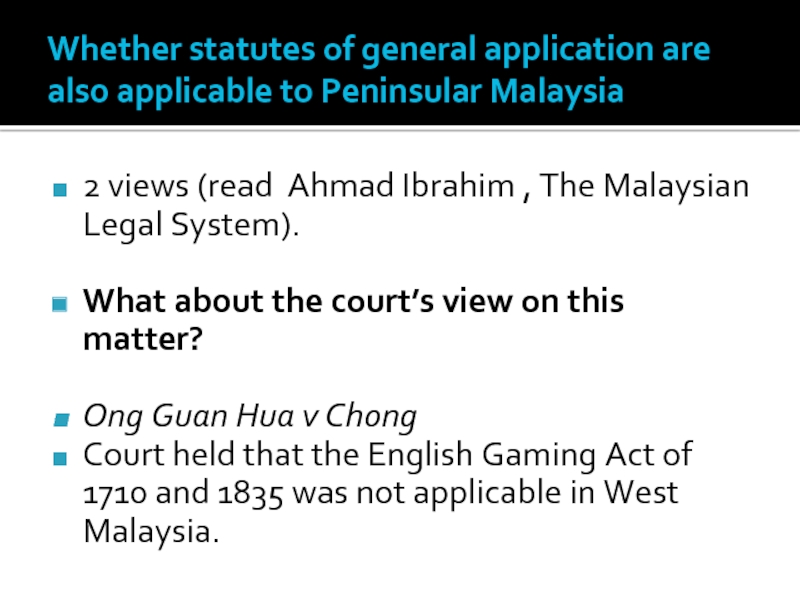
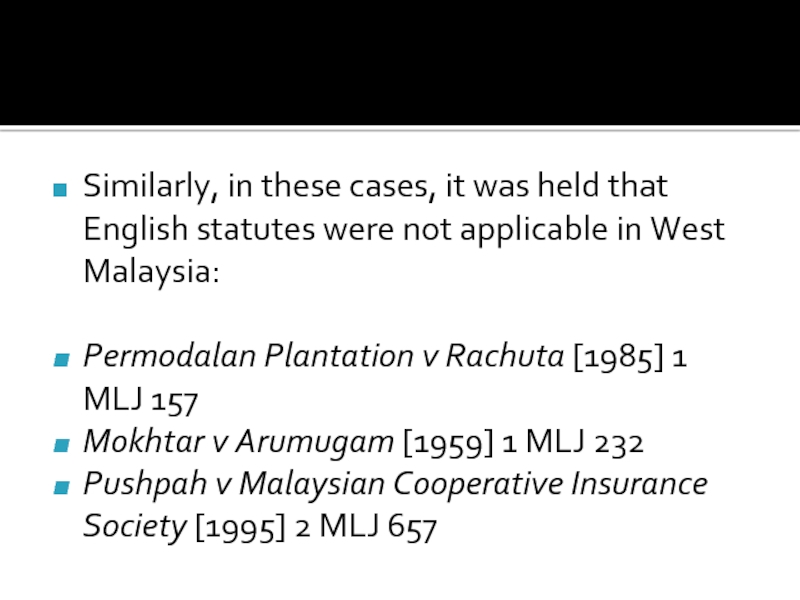
![Mokhtar v Arumugam [1959] 1 MLJ 232Court:“It is quite clear that in England the power](/img/tmb/1/25189/4e48bf7989c4719ce8759bb9e758e91b-800x.jpg)
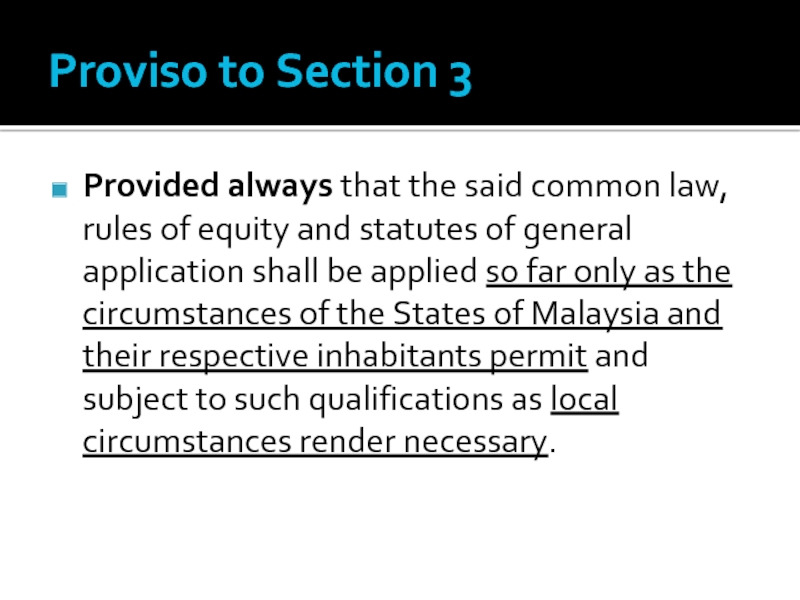
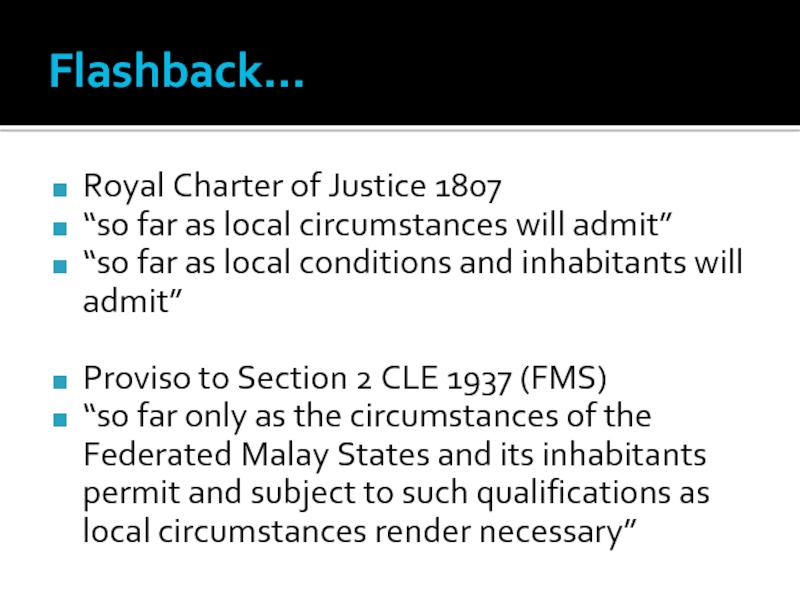
![PL Narayanan v PL Subarmaniam [1998] 4 CLJ Supp 428“Under the Ordinance or Act, there](/img/tmb/1/25189/23ad5bf51dd20cf43afe6548749844a2-800x.jpg)
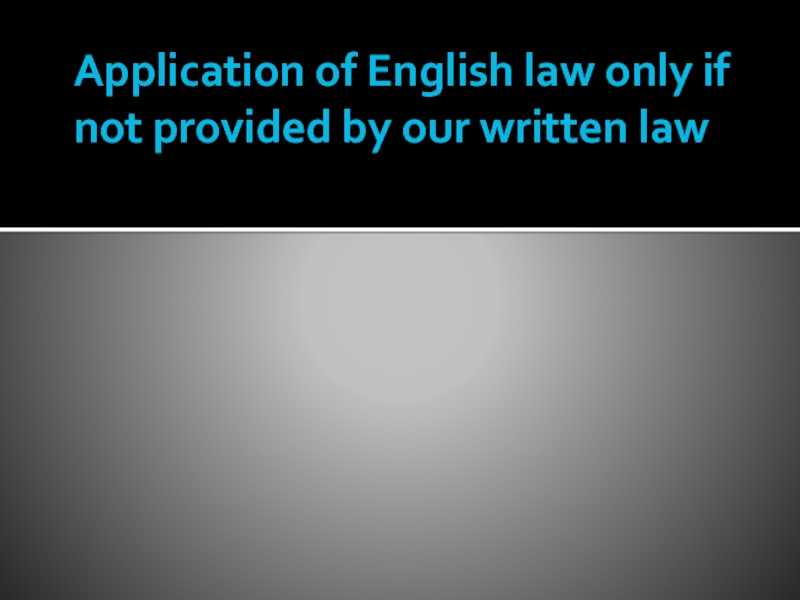
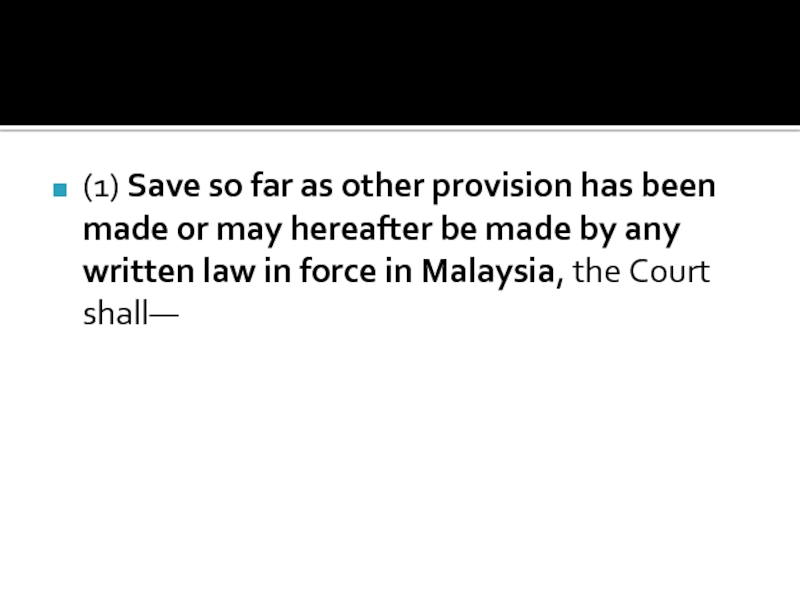
![Dato Seri Anwar Ibrahim v PP [2010] 7 CLJ 397Once there is written law in](/img/tmb/1/25189/42ed2e7e1c862df8db25a3c6e99e6ae8-800x.jpg)
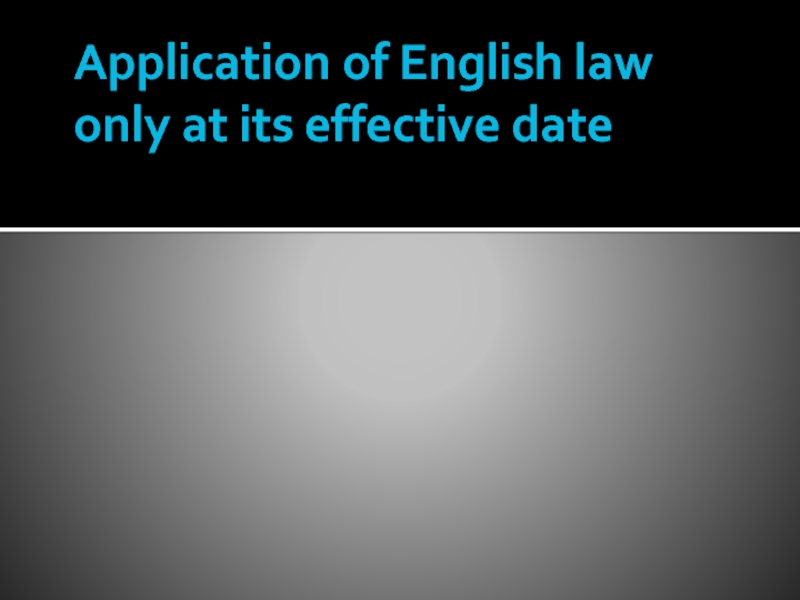
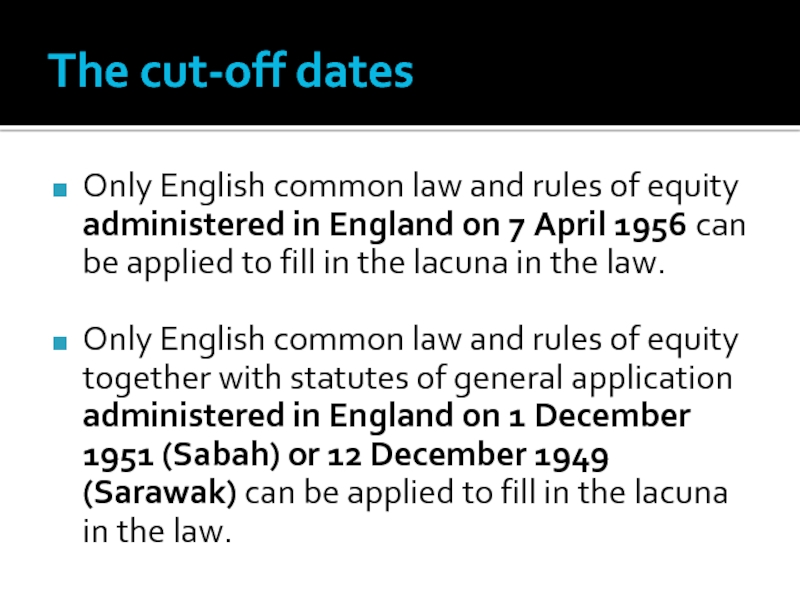

![Pang Soo v. Tong Ah Company Sdn Bhd [2010] 2 CLJ 482Nuisance is a cause](/img/tmb/1/25189/8b0aed538e78d1d9e1b4f8e0c3ef3f2f-800x.jpg)
![Leong Bee v Ling Nam Rubber Works [1970] 2 MLJ 45A common law presumption that](/img/tmb/1/25189/6994fba8548ccb45c20b4b65a9f018bb-800x.jpg)
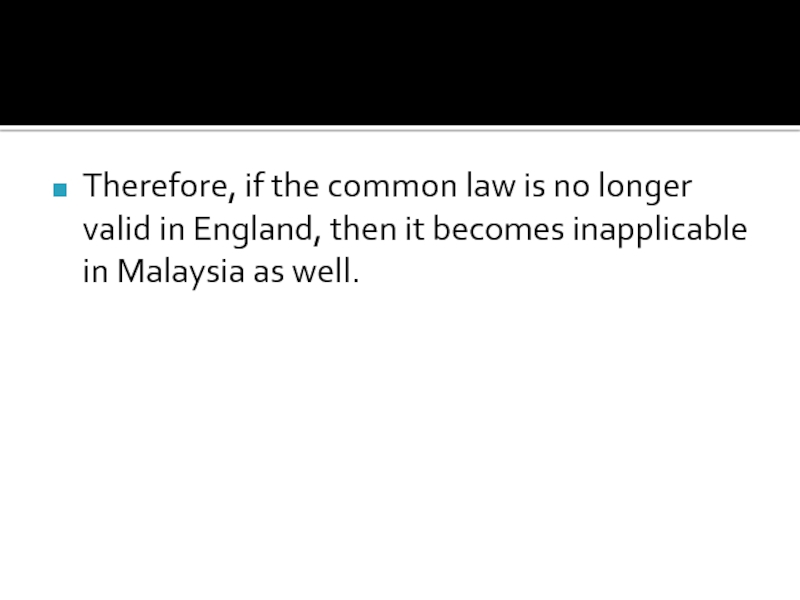
![Jamil bin Harun v Yang Kamsiah [1984] 1 MLJ 217The Federal Court ordered the trial](/img/tmb/1/25189/4d495265845741183fd4a0b1d1f0b9e1-800x.jpg)
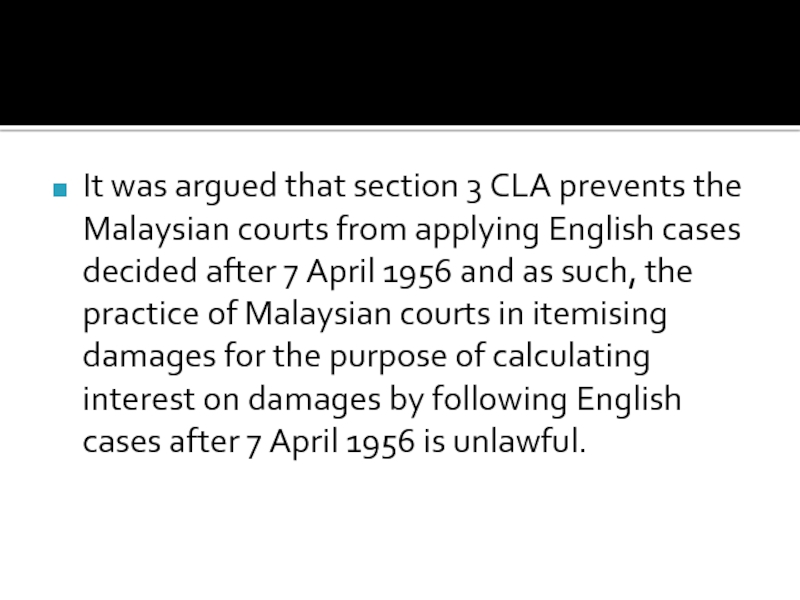
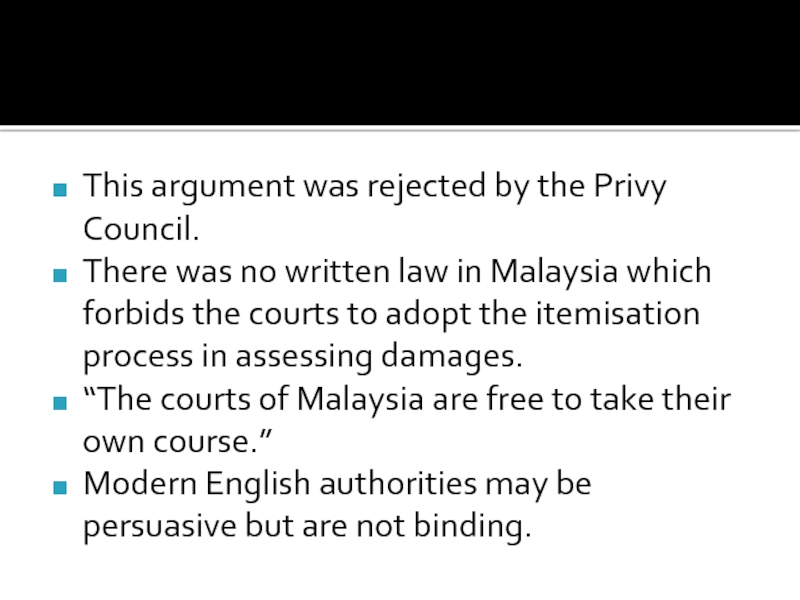

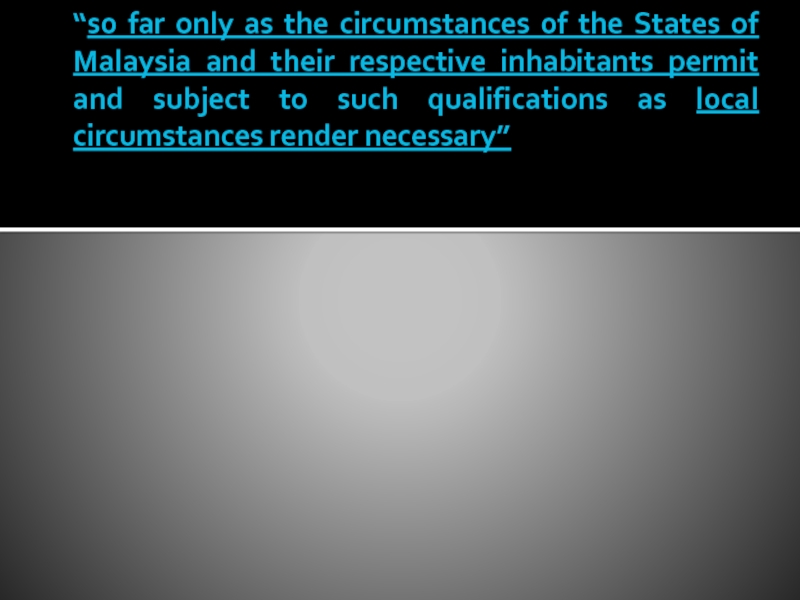
![Commonwealth of Australia v Midford (Malaysia) Sdn. Bhd. [1990] 1 CLJ 77, . [1990] 1](/img/tmb/1/25189/271a38ac2801d6b745fbc3d0cc683fea-800x.jpg)
![Nepline v Jones Lang Wootton [1995] 1 CLJ 865Court applied the proviso to S 3.Abdul](/img/tmb/1/25189/6f7fe57efb6110cf36dacae655c7b4cc-800x.jpg)
![Syarikat Batu Sinar v UMBF Finance [1990]Court applied the proviso to S 3.“The practice in](/img/tmb/1/25189/98951d6bea5b5c5c1305c5ff78b4bfbf-800x.jpg)

![Nepline v Jones Lang Wootton [1995] 1 CLJ 865Abdul Hamid J:“In applying s.3 of the](/img/tmb/1/25189/1dcfc74e679526889429579751139b08-800x.jpg)
